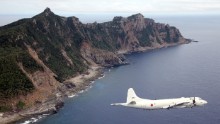
The Japanese Self Defense Force debuted their newly formed Amphibious Rapid Deployment Brigade (ARDB) on Saturday, at a military display near Sasebo, on the southwestern tip of Kyushu Island.
About 1,500 members of the new unit conducted a public exercise, camouflaged with khaki stripes, imitating recapturing a Japanese island from an invading army.
The unit gives Japan its first marine troops since World War II.
"Some question if the Japanese government may consider using safeguarding territorial integrity as an excuse to revive militarism, to which regional countries must stay on high alert," the article said.
Chinese Foreign Ministry spokesman Geng Shuang said Monday Japan's military moves were being followed closely by their Asian neighbors "for historical reasons."
Relations between Beijing and Tokyo have been strained since the end of the Second World War, stemming from the Japan's wartime occupation of mainland China.
Japan's amphibious forces growing
The new Japanese unit was announced by Defense Minister Itsunori Onodera at the Ministry of Defense on March 31, who said it would be composed of about 2,100 personnel.
"In the event of an invasion of a remote island, its task will be promptly landing on the island and regaining and securing it," Onodera said at a press conference.
Split into two amphibious deployment regiments, the unit is equipped with amphibious vehicles and will continue training with US military forces, a Japan Self Defense Forces press release said.
Defense Minister Onodera added the brigade would continue training with US-built military aircraft, the V-22 Ospreys, which can be used for long-range flights and take off and land like helicopters.
Japan's naval forces also have ships well-suited to amphibious operations, including its helicopter destroyers, four of which have been commissioned in the past decade.
Those ships, which look a lot like a small aircraft carrier, could be configured to carry stealthy F-35B fighter jets, which can land vertically. They are also platforms that accommodate the V-22.
Despite the activation of the new unit and the hardware supporting it, Japan's marines are far from being an effective fighting force, according to Grant Newsham, senior research fellow at the Japan Forum for Strategic Studies.
Newsham said in a blog post Japan must be able to integrate the marines with its air and naval forces.
The Chinese government has repeatedly said it would be prepared to defend the islands claimed by Beijing in the East China Sea if they were taken by force.
"China resolutely defends its territorial sovereignty and any attempt to infringe upon China's sovereignty over Diaoyu Islands will be futile," Lu said according to Xinhua.
Japan's military revival
Japanese Prime Minister Shinzo Abe has long sought to change his country's pacifist constitution, adopted after the Second World War, to allow Japan to maintain armed forces.
Currently Japan has a military known as the Self-Defense Forces, but the constitution bars it from "the threat or use of force as means of settling international disputes."









 Add Category
Add Category
